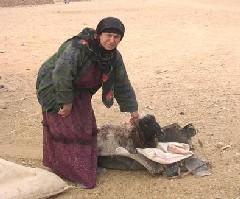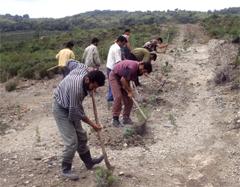From Architecture to AI-Powered Building Diagnostics: Tarek Rakha’s start-up story
10 June 2025
Published online 27 September 2010

According to assessment missions by Syria's government and the United Nations (UN), some 1.3 million inhabitants of eastern Syria have been affected by a prolonged drought over the past four years. Around 803,000 inhabitants have lost almost all of their livelihoods and face extreme hardship.
Small-scale farmers have been the worst hit, often failing to make enough money to feed their families. On average, herders in the region have lost around 80% of their livestock over the past three years.
Drought is a familiar phenomenon in the area, but the severity and reoccurrence is changing. This is attributed to changes in the quantity and distribution of rainfall brought on by climate change, especially during the critical crop development phase of the growing season.
One of the most visible effects of the drought is the large migration of people from the affected areas that increased substantially in mid-2009. Figures for migration range from 40,000 to 60,000 families. The assessment's findings indicate that rural people have resorted to sell their personal belongings to buy food for their families.
Data from the clinics in the affected area reveal that children under three years of age are malnourished and receive an insufficient intake of protein and essential nutrients for proper growth. Many parents have withdrawn their children from elementary schools and are sending them to work to bring a little extra income for their families.
According to the government of Syria, an estimated 36,000 households originating from Al-Hassake Governorate (200,000 – 300,000 persons) have migrated to the urban centres of Damascus, Dara'a, Hama and Aleppo as of June 2009, Temporary settlements and camps were set up by the government to house the displaced population. This move exacerbates the strain on resources, public services and unemployment, a situation already struggling to cope with one million Iraqi refugees.
The drought-induced exodus increases pressure on urban infrastructure and services and undermines economic growth, and could hinder local and national development. It also leads to worsened health, education and social indicators among the migrated population.
The rainfall in the rainy season of 2009/2010 was much better for the eastern area of Syria compared to the previous three years. However, the effects of the previous years of drought on local people are still evident. To make things worse, cereal production has been reduced by the emergence of a new strain of yellow rust (a cereal disease) during the 2009/10. This has reduced the productivity in the most fertile northeastern part of Syria, by 30-50%. So the effect of the drought lingers in the lack of income for poor farmers, hindering capacity to overcome the economic and social effect of that drought.

By its very nature, droughts hit the poorest people hardest, since they are the least prepared to cope with it. The Syrian government has supported development of the Syria Drought Response Plan (SDRP). They have announced through the UN websites and communications that it welcomes international assistance that may be provided to the drought-affected population either through multilateral channels, such as the SDRP, or through direct bilateral channels.
An announcement from the Ministry of Agriculture (MAAR) listed the most urgent sectors that donor countries might wish to consider for bilateral assistance. The director general of the Badia Commission also welcomed the international assistance provided to the drought-affected populations and technical assistance aimed at improving management of natural resources in the drought-affected areas.
Despite considerable efforts by the Syrian government to assist the drought-affected populations, the cost of providing continued food assistance and in-kind agricultural support to the affected population is beyond its capacity. Need for assistance continued until May-June 2010, when this year's crops matured. The current needs of farmers and herders also exceeds the assistance that has been provided to date, as the losses in crops and herds may not be fully offset by the next harvests.
From 2008 and up to July 2009, the Syrian government supplied 5,600 metric tonnes of food to about 96,600 severely affected households. Food rations have varied in terms of quantities according to distribution periods, but all have included wheat flour, lentils, oil, pasta, dates and bulgur. In the severely hit Al-Hassake region, the government has also complemented 5,200 World Food Programme (WFP) food baskets with two litres of cooking oil, two kilograms of ghee and one kilogram of tea.
Farmers get direct support as well. The government provides subsidized livestock that covers 13% of the farmers' annual needs, as well as free medicine and vaccines for their animals as well as access to protected pastures. It has also offered support for fuel needed for irrigation and increased the selling price of cereal crops, allowing farmers to make ends meet with what little harvest they have.
The government has promised to continue distributing food in the Al-Hassake area according to people's needs. Several other plans are in the pipeline, such as provision of seeds to farmers while waiving their loan repayments for at least a year.
Within its overall mission, ICARDA is helping the Syrian government improve technology. Based on ICARDA germplasm and in collaboration with Syrian researchers, many varieties of cereals (wheat and barley) and food legumes (chickpea, lentil and faba bean) have been developed that are tolerant to drought and/or pests and diseases, resulting in widespread use by farmers.
Supplemental irrigation and water harvesting techniques, which augment the water available for rain-fed crop production, are important options in adapting to drought and climate change. ICARDA is a pioneer in the development of these techniques and the centre has worked closely with the Syrian partners on these aspects. Supplemental irrigation has been tested and is now adopted on a large scale. Water harvesting techniques have been implemented in the Syrian steppe regions. ICARDA is also testing conservation agriculture methods (minimum tillage, direct seeding etc.) together with Syrian colleagues. These methods help conserve soil moisture and soil fertility and reduce fuel and energy use, and have already improved crop yields on farmers' fields in Syria.
The drought in Syria may be slowly coming to an end, but the dry three years are having prolonged effects. It may be several years before life can return to normal in the northeastern part of Syria, but rural communities will need additional help in adjusting their production systems and practices to cope with the effects of global climate change in the future.
Mahmoud Solh is the director-general of ICARDA (International Center for Agricultural Research in the Dry Areas), Aleppo, Syria.
doi:10.1038/nmiddleeast.2010.206
Stay connected: